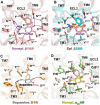Structural insights into ligand recognition, activation, and signaling of the α2A adrenergic receptor
- PMID: 35245122
- PMCID: PMC8896805
- DOI: 10.1126/sciadv.abj5347
Structural insights into ligand recognition, activation, and signaling of the α2A adrenergic receptor
Abstract
The α2A adrenergic receptor (α2AAR) is a G protein (heterotrimeric guanine nucleotide-binding protein)-coupled receptor that mediates important physiological functions in response to the endogenous neurotransmitters norepinephrine and epinephrine, as well as numerous chemically distinct drugs. However, the molecular mechanisms of drug actions remain poorly understood. Here, we report the cryo-electron microscopy structures of the human α2AAR-GoA complex bound to norepinephrine and three imidazoline derivatives (brimonidine, dexmedetomidine, and oxymetazoline). Together with mutagenesis and functional data, these structures provide important insights into the molecular basis of ligand recognition, activation, and signaling at the α2AAR. Further structural analyses uncover different molecular determinants between α2AAR and βARs for recognition of norepinephrine and key regions that determine the G protein coupling selectivity. Overall, our studies provide a framework for understanding the signal transduction of the adrenergic system at the atomic level, which will facilitate rational structure-based discovery of safer and more effective medications for α2AAR.
Figures






References
-
- Link R., Daunt D., Barsh G., Chruscinski A., Kobilka B., Cloning of two mouse genes encoding alpha 2-adrenergic receptor subtypes and identification of a single amino acid in the mouse alpha 2-C10 homolog responsible for an interspecies variation in antagonist binding. Mol. Pharmacol. 42, 16–27 (1992). - PubMed
-
- Ruffolo R. R. Jr., Nichols A. J., Stadel J. M., Hieble J. P., Pharmacologic and therapeutic applications of alpha 2-adrenoceptor subtypes. Annu. Rev. Pharmacol. Toxicol. 32, 243–279 (1993). - PubMed
-
- MacDonald E., Kobilka B. K., Scheinin M., Gene targeting - Homing in on α2-adrenoceptor-subtype function. Trends Pharmacol. Sci. 18, 211–219 (1997). - PubMed
-
- Wang C. D., Buck M. A., Fraser C. M., Site-directed mutagenesis of alpha 2A-adrenergic receptors: Identification of amino acids involved in ligand binding and receptor activation by agonists. Mol. Pharmacol. 40, 168–179 (1991). - PubMed
Publication types
MeSH terms
Substances
LinkOut - more resources
Full Text Sources
Research Materials

